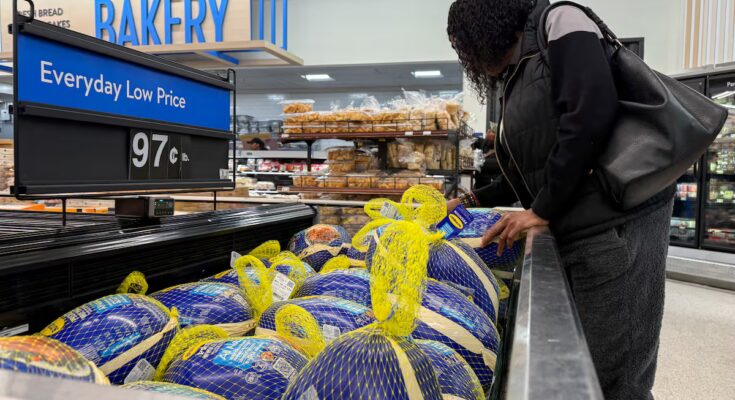The English word convenience translates into Spanish as convenience. Accessible quality, according to RAE. It’s also a nightmare for millions of Americans who can’t make ends meet because the shopping cart is prohibitively expensive, because they can’t afford to buy a house, because they’re stuck on their children’s school bills or simply because they can’t provide for themselves. It is also a political topic that runs through American politics, from California to New York. Also passing through Washington.
In an effort to ease rising food prices, the White House signed trade deals this week to reduce tariffs on some foods, such as coffee, bananas or beef, among others. But economists don’t think that’s enough. “We estimate that the reduction in overall inflation would be minimal at best,” explains Bernard Yaros, head of economic analysis at Oxford Economics.
The cost of living is the top concern for nearly half of Americans (47%), according to a poll released a week ago by CNN. Socialist candidate Zohran Mamdani made affordability the banner of his innovative political campaign that led him to win the mayoralty of the largest US city earlier this month. Mamdani has promised to freeze rents, make public transport free and create a network of public supermarkets. Her party colleagues Abigail Sparberger and Mikie Sherrill won on the same day to become governors of Virginia and New Jersey respectively, appealing to the same issue despite representing different sensibilities within the Democratic Party.
In the opposite direction, the politician who became famous by firing the workers of a television program did not take long to react. Donald Trump first denied the phenomenon, calling it a “hoax” and something Democrats had invented. Then he refused to talk about it when reporters asked him: “The reason I don’t want to talk about affordability is because everyone knows it’s a lot less expensive under Trump than under sleepy Joe Biden. The only problem is, Republicans don’t talk about it.”
Soon after, the president clarified his new vision of this crisis on Truth, his social network: “According to Walmart, Thanksgiving dinner 2025 under Trump costs 25% less than Thanksgiving dinner 2024 under Biden. My costs are lower than Democrats in everything, especially oil and gas! So the Democrats’ affordability issue is dead! Stop lying!” Economists agree that Walmart’s dinner may be cheaper than last year, but that’s because it contains fewer products.
The affordability or shopping basket crisis is nothing new in the United States. Trump hammered his predecessor, Joe Biden, with this argument during his last term. It was one of the three aces of the electoral race that brought him back to the White House, together with tariffs and immigration. But now it has turned against him. The issue has given Democrats wings and is angering many American citizens who are disenchanted with the Republican economic agenda.
Trump’s tightening of trade policy, with tariffs spread across the world, is fueling the price spiral. The latest official data shows that shopping carts became more expensive by 3% in September, the biggest increase since January. Although inflation is more controlled than expected, it continues to leave a hole in families’ pockets.
Sustainability has suddenly become a central political issue, explains Paul Donovan, chief economist at investment bank UBS. “People are outraged by the loss of housing affordability and tend to blame the governments in power.” This economist, boxing and apple-growing enthusiast explains that affordability is a little different from the cost-of-living crisis. Includes price increases. “I can’t pay it” is the main reason for people’s anger,” he adds.
“Affordability is a recurring theme in American politics,” adds Yaros of Oxford Economics. “Health subsidies were the centerpiece of the government shutdown, and the possibility of a 50-year mortgage was raised as a measure to improve access to housing.”
While inflation is a general increase in prices, affordability typically refers to specific, large expenses, such as purchasing a home or car. “Affordability also includes a kind of aspiration. People want things and get frustrated when they can’t afford them,” Donovan continues. Him convenience It can pose a problem even when the level of overall inflation is kept under control.
The proximity of Thanksgiving and the Christmas holidays doesn’t help deflate the debate. November and December account for a disproportionate share of retail spending in the United States. The weeks remaining until the end of the year represent a considerable part of the annual expenditure of all families. According to Bank of America, in these two months more than 20% of credit card spending is concentrated on general goods, electronics and clothing. “Consumers spend more in stores, but get less and perhaps opt for lower quality services,” explain the analysts.
The problem worsened because the debate intensified when Trump decided to renovate the East Wing of the White House to build a luxurious ballroom, with marble and sumptuous furniture. He also spoke several times about renovating the bathroom in the Lincoln bedroom, in the presidential residence, with gold and marble ornaments. Their taste for ostentation and luxury does not help the general debate on the cost of living.
Then he decided to go on the offensive. His team of advisers admits that they are developing a strategy to try to regain the initiative in this area, according to several American media. “I have called on the Department of Justice to immediately begin an investigation into meatpacking companies that are raising prices through illegal collusion, price fixing and manipulation,” Trump wrote this week on Truth, the social media platform through which he expresses his views.
This week the president also struck trade deals with Argentina, Ecuador, El Salvador and Guatemala that will allow him to lower the price of coffee, bananas, beef and other foods.
The situation, however, does not seem easy to control. House prices and rents have skyrocketed in the country’s big cities, where it is difficult to find apartments for less than $2,500 (2,150 euros) a month. In supermarkets the shopping cart continues to become more expensive. Even the cheapest ones, like Costco, are now more expensive than they were a year ago. A survey of Washington PostABC News and Ipsos revealed that a majority of Americans say they are spending more and more on food and utilities.
Consumer confidence in the United States fell this week to its lowest level in three years. Auto loan defaults among subprime borrowers have reached the highest level since 1994, according to data from ratings agency Fitch.
The six-week federal government shutdown, the longest in history, and tariffs have hit Americans hard and highlighted the country’s growing inequality. “Large differences persist between spending and wage growth of higher-income and lower-income households,” concludes a Bank of America report released this week. “In October, higher-income households saw spending growth of 2.7% year over year, while those with lower incomes lagged behind at just 0.7%.”
Added to this, nearly 1.4 million federal workers went 43 days without receiving a paycheck due to the government’s administrative shutdown, given the acrimony of Republicans and Democrats over extending the budget.
A delicate situation because one in four Americans admits to living hand to mouth, according to Bank of America. Their survey reveals that 24% of families spend more than 95% of their income on basic needs, leaving little or nothing for other expenses such as dining out or going on vacation. Not to mention buying a house.
“Trump is in serious trouble and I think it’s something more serious than just the cost of living,” Lindsay Owens, executive director of Groundwork Collaborative, a progressive economic analysis group, told the AP.


